Friends, my quest for well-documented and well-rounded roles for women in military living history goes on, but this past weekend I feel as though I had a victory.
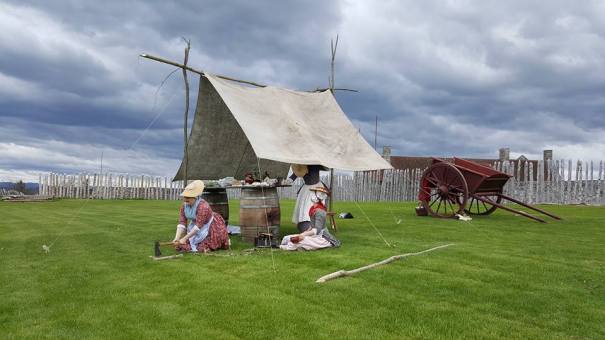
Opening Weekend saw my museum’s staff running a living history event the theme of which was the construction of a redoubt*. This was an activity which we could document to the year we are representing (1777), and nearly to the day of our opening weekend (early May) as well.
To round out the event, we also set up a market to sell foodstuffs and other goods to the soldiers. This market seems to have been something of an institution at this site. Its presence and location are noted in orderly books the previous fall, and again in February. The “traders and hucksters” consisted of local inhabitants, and members of the military community such as licensed sutlers. The probability of women running or helping to run said stalls was high, and so the market stall became my project.
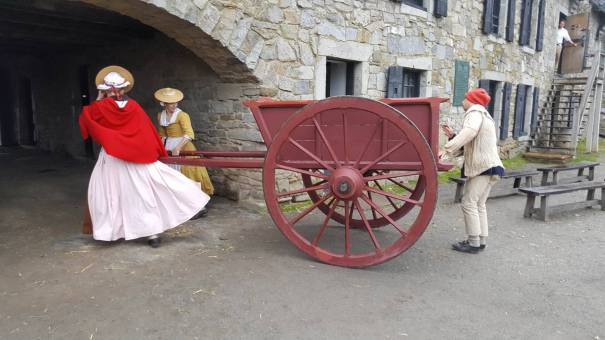
My co-conspirator in the execution of this program was Ms. F. (long-admired from afar by myself for her bad-assery in going it step for step with the men on many a re-created soldiers’ march). She arrived on Friday, and much to my satisfaction, we proved a capable and relatively self-sufficient team in the design, assembly, maintenance, and running of a productive and profitable market.Though we required extra hands to raise and stake out our shelter – a detail of men was kindly sent our way by Lieutenant S. to fulfill this function – the design and execution of the stall set up was in our own hands. This produced a deeply satisfying sense of ownership with the whole project.
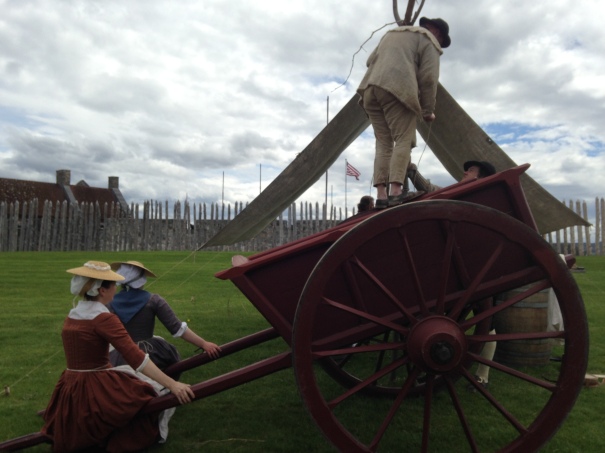
It had been decided that the soldiers at work digging the redoubt would be “paid” in continental currency (2 1/3 dollars per man), and that money would be valid at the market. The site would foot the bill for some provisions, and soldiers would be able to “buy” said provisions to supplement their rations of meat and flour.
Though documentation exists for the costs of various goods sold in the military camp that year, exchange rates and values proved exceptionally hard to pin down, as they were given in several currencies, and fluctuated with supply and demand. With the realization that the relative value of continental dollars, Spanish silver, and half a dozen other currencies was beyond the scope of my research time, I did what any good business woman would: I decided to let the market drive my prices: rates would rise and fall based on the market’s supply and the soldiers’ demands.
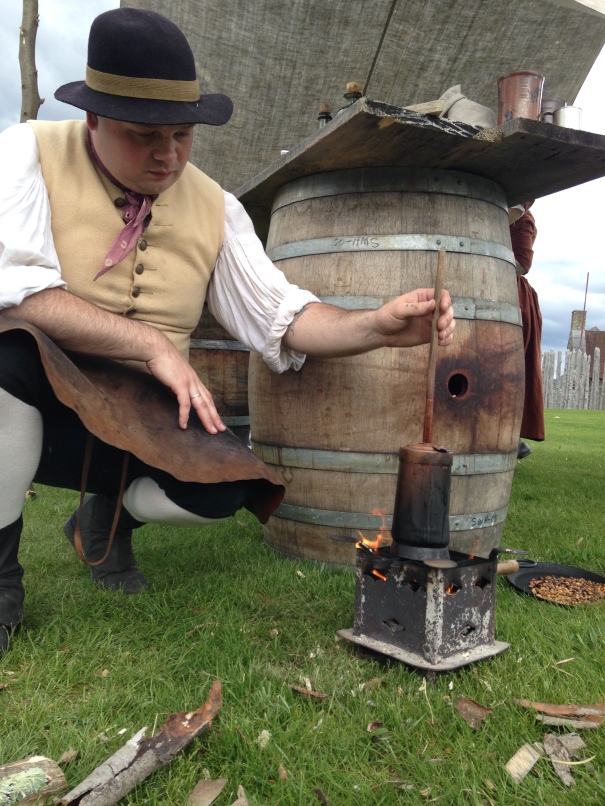
What did we sell? Early May in the north country means little new produce, though we did rustle up some green onions and asparagus. Otherwise, vegetables were last year’s cellar crops: cabbage and carrots (these proved more popular than the spring greens anyway). Other goods were chosen because they allowed us to discuss some of the more interesting points our research had uncovered: the exceptionally high price of cheese was mentioned more than once by soldiers writing home from this post, and so we had to have some for sale. Likewise, drinking-chocolate was a frequently discussed food stuff, and so we set up a brazier in order to cook pots of wine-chocolate (brewed with a portion of Madeira, and a genius invention if their ever was one), to be sold by the glass.

Operating the market felt a bit like being children playing shop: the soldiers gave us their fake money, and we made-believe it had real value. But, just as in the best games of make-believe, we achieved a level of realism: we truly made a miniature economy. Just as the market in 1777 was supplying a self-contained and captive market at this isolated military encampment on the shores of Lake Champlain, we too had a captive market of busy soldiers. By selling foodstuffs which the reenactors could plan to buy ahead of time, there was a necessary level of interaction between us (the sellers; women) and the soldiers (our customers; men). This same level of interaction occurred when soldiers received orders to assist us in setting up the stall, and even when we bribed Private Bevan into splitting firewood for us in exchange for a cup of chocolate. Our artificial marketplace made for genuine interaction between two sets of gendered** activities. In my experience in living history, this is very very rare. Almost never do the “women’s” interpretive projects feel like anything besides a side show. Never before have I felt as though I, a woman portraying a women in a military setting, have had so much value, or been so integral to the running of a camp.
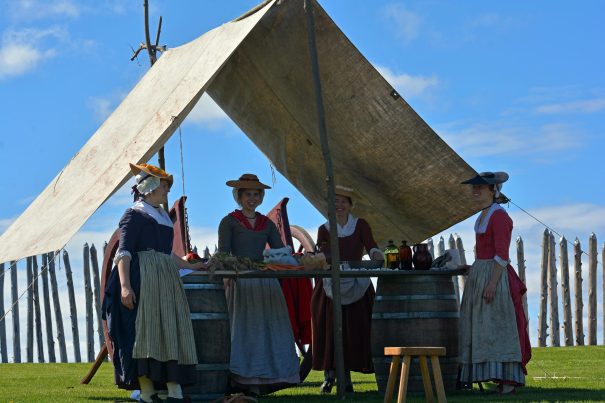
I believe that the level of interaction between reenactors and the market was largely due to the way in which research and information was shared with event participants. At some of our other recent events, research about “womens'” or “camp follower” interpretation has been shared selectively, with those who would be participating in the activities. For this event, I wanted to make sure that knowledge of the market stall would be more broadly distributed, so that not only the sellers, but also the buyers would understand the context of the display, making interactions more meaningful. To this end, the market stall research was shared with all of the participants. Likewise, we drummed up interest by posting updates on our plan for the market directly to the Facebook event page, in the same way information about the redoubt itself was being shared.
This was an important step, because instead of isolating those specific persons who would be participating in the execution of the program, we normalized the presence of the market (and the women running it) by putting this research on an equal footing with the research and information going out about the military activities at the site. This normalization of non-military activities, and women’s roles made this event more satisfying for me, and I think more cohesive and well rounded for all.
*Redoubt: a fortification with walls; sort of a mini-fort. In this case six-foot high wall of earth and sticks, on the perimeter of a 40’x40′ square.
** Running a market stall is far from a gendered activity in the 18th century, but for the purposes of this living history event, it became the “women’s project”, as the men were largely occupied in redoubt construction. I should add that another piece of marvelous “women’s” interpretation was happening simultaneously in the garden, where Miss Margie and Miss V. were industriously doing laundry. They too encountered positive interaction when sweaty, dirty soldiers dropped off shirts (and in one case, overalls) for a wash, once again paying in their Continental Dollars.
HUZZAH! Need more normal interaction AND economic influences. ALSO: deeply curious about the chocolate pot.
LikeLike
We didn’t make it for opening weekend but we really enjoyed reading about this — and we wish we had especially now. Thanks!
LikeLike
Everything about this is fabulous and as a participant in male dominated events here in the Midwest (a few of my men were at your event and really enjoyed their time), I would like more interactions like this to occur at our events here. Thank you for this post and for experimenting and sharing knowledge.
LikeLike
This is a wonderful blend of research, interpretation, and imagination – and no small part of organization. Kudos!
LikeLike
What a great idea, and obviously well executed!
LikeLike
Hmmm…chocolate wine bottled with a Fort Ti label? I am curious about the area surrounding the fort in 1777. It seems to be a harsh environment for farming and isolated (as you mention in this post). Was there a settlement nearby? I am guessing that there were what we would call the ‘middlemen’ (and women) who would buy from farmers and then resell the goods for a profit, purposely following an army? How about craftspeople? The fort had it’s own boot maker and tailor, but were there traveling or local craftspeople mentioned in journals or letters? An army near a populated area would have numerous ways to part with their coins, and certainly more women involved as shopkeepers, etc, so this is interesting to see what can be done at a site such as Fort Ticonderoga.
LikeLike
Fantastic! This is so exciting!
LikeLike
Spectacular interpretation and a wonderful write-up about it, as well. I look forward to seeing this kind of interpretation more frequently!
LikeLike
Wonderful setup! I’m going to keep this in mind when/if organizing events in the future.
LikeLike